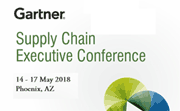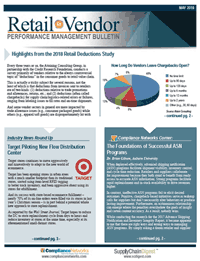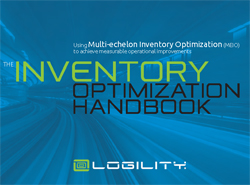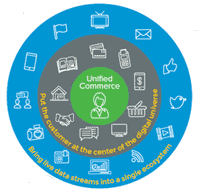Gartner Supply Chain Executive Conference 2018 Part 2
After a week break to report and comment on the Gartner Top 25 Supply Chains for 2018, I am back with part 2 of my trip report on Gartner's well-attended 2018 supply chain executive conference, as usual in Scottsdale, AZ a couple of weeks ago.
As promised in part 1, this week I am going to focus on breakout sessions over the two days I was at the conference. Again, I will note these breakouts largely toggle back and forth between sessions that feature Gartner analysts - often with a co-presenter from some company's supply chain - with session times paid for by vendors, which are all over the map in terms of approach and quality.
The most ambitious presentation from Gartner analysts over the two days I saw was one from Paul Lord around so-called governance for inventory management in an enterprise.
| GILMORE SAYS: |
Are transportation patterns actually consistent in practice with the assumptions and forecasts used to optimize a company's supply chain network design?
WHAT DO YOU SAY?
Send us your
Feedback here
|
I will note Lord actually presented something similar at the conference two years ago. The term governance really kind of came out of the general IT community more than two decades ago, and really refers to rules and procedures under which a function operates, providing guidance and clarity.
So the idea here is that for all the focus on inventory - often primarily from a financial perspective in terms of working capital, turns, etc. - those types governance rules are often not really formally developed to guide inventory decisions.
A related framework from Lord involves identifying what he calls the three types of decisions that affect inventory. First, there are structural decisions - i.e., what your network looks like or how many SKU are carried, that will lock in a certain amount of inventory levels.
There are also operational decisions, most often involving familiar supply chain tradeoffs, such as inventory versus transportation, EOQ, modal decisions and more. Those choices obviously effect inventory levels.
Least well understood are what Lord calls situational decisions. Those include things like how much inventory to buy when there is a risk of a supply shortage, how much inventory to build for each NPI, similar decisions about promotional events, etc. We need more insight into how these decisions are or should be made in these areas, Lord says.
There's a lot more I don't have time for here, but this is interesting thinking for sure, but I would caution Lord the material is bordering on coming across as being too academic in tone and substance. There will be the research itself and how it is presented - both will be equally important.
On day 1 there was a presentation described as covering sort of a new era for supply chain collaboration, featuring Ana Dzura of Unilever. It turned out to not really cover what I was hoping for - new, enlightened thinking about collaboration between manufacturers and retailers - but was interesting enough.
What was very interesting was the creation in 2017 of what Unilever calls a "Digifund." This is money available to Unilever supply chain managers to fund innovative digital ideas they may have - up to 10,000 euros at a crack. Managers submit short videos describing the project - and if managers don't receive a decision within 48 hours, the request is automatically approved.
One Unilever manager used the funding to apply AI to data on supply chain performance between the company and a major retailer. Previously, data analysis took up most of the available time, Now, the AI tools does the number crunching, and Unilever and the retailers can use the time much more productively.
Also cited was a successful on-line collaboration among several suppliers on a design for a new bottle that would use a lot less plastic. In the past, Dzura said, collaboration was more one on one with suppliers.
Unilever also used social media to get feedback directly from a pool of customers on a new product idea. The result was valuable insight in just weeks versus many months in the way such new product testing was traditionally done, frankly by cutting out the middlemen in the process.
A session on ecommerce and the impact on logistics from Gartner analysts Tom Enright and my friend Greg Aimi covered a lot of ground. They discussed how what channel receives credit for omnichannel sales impacts behavior, and thus "The CFO is determining customer service policy."
It was stated that in 37% of on-line orders, the customer wants to change the delivery location after the order is initially placed, up from 24% a couple of years ago. Can this be right? I have never done that once.
Aimi made the interesting point that in the past, details about delivery were largely determined after the order was received. Now, companies need to know service, delivery date, cost, etc. before the order is placed to inform the potential customer - a much different challenge.
It was also stated that product searches on Amazon equal searches on all other US retail web sites combined. Wow.
I only had time for about half of a session on becoming an analytics leader, hearing what Gartner analyst Noha Tohamy had to say on this, but missing the presentation from a Monstanto manager, who is apparently working in such a role.
This session was really about what it takes to be personally successful in being given the role of head of supply chain analytics - and increasingly common position - not about achieving company success, though of course those are interrelated.
 Tohamy said a big risk is that business leaders will simply expect the new analytics effort will produce many impactful results very quickly - too quickly - and that the leader needs to talk down unrealistic expectations right away. It's a process. Tohamy said a big risk is that business leaders will simply expect the new analytics effort will produce many impactful results very quickly - too quickly - and that the leader needs to talk down unrealistic expectations right away. It's a process.
An interesting question is where such a supply chain analytics capability should sit in the organization. There are really three choices: a COE within the supply chain, a more distributed approach where analytics talent is embedded in various functional or process teams, or a more corporate approach where supply chain analytics are supported out of an enterprise analytics team that also provide services sales, marketing, finance, etc.
All of the above can work, though Gartner's research finds modestly better results coming from the supply chain COE approach versus the other two.
Tohamy also recommended thinking broadly about metrics, starting of course with demonstrated cost savings from the analytics, such as reduced inventory, but also then improvements that indirectly drive down costs or improve revenue, such as from more accurate forecasts, and even process improvements, such as the time it takes to get answers to questions from business executives.
I went to one of the paid for sponsor sessions, this one of how freight pay and audit can drive major transportation improvements, put together by a company called Trax that provides such services.
Frankie Mossman, VP of Global Logistics and Materials at Honeywell, had a number of interesting things to say, noting for example that until you can get actual invoice data and understand what you are really spending, you can't really optimize logistics.
Apparently, there are still lots of companies that still do little in the way of freight bill auditing, with the consensus being such a program is likely to reduce freight spend 2 to 5%. But Mossman and fellow presenter Alfredo Comacho of manufacturer Blount both emphasized the real value comes from the opportunity to leverage the spend and performance data in other ways - which both speakers require in carrier contracts - to identify opportunities for supply chain improvements.
For example, are transportation patterns actually consistent in practice with the assumptions and forecasts used to optimize a company's supply chain network design?
Mossman also said that in many companies transportation invoices receive the wrong G/L code - you really have to root this out - and that in the end, the improvements from the audit data and process have to clearly fall to the P&Ls of the business - else the effort is largely for naught.
These are more, but I am out of space and not bothering with less effective sessions. Hope these two reports have been useful.
Any reaction to Gilmore's summary of Gartner breakout sessions? Do we need more "governance" around inventory? Let us know your thought at the Feedback button below.
|



![]()

![]()

![]()









 Tohamy said a big risk is that business leaders will simply expect the new analytics effort will produce many impactful results very quickly - too quickly - and that the leader needs to talk down unrealistic expectations right away. It's a process.
Tohamy said a big risk is that business leaders will simply expect the new analytics effort will produce many impactful results very quickly - too quickly - and that the leader needs to talk down unrealistic expectations right away. It's a process.


